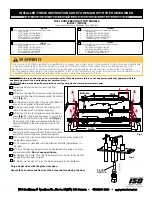
Page 25
5. Using the brush, clean the walls and floor of the burn chamber.
6. Open the ashtray slightly and pull on each ash gate until the ash falls
from the burn chamber into the ashtray. Sweep remaining ashes into
the ashtray. For insert models, scoop out the ashes into a metal
container with a tight fitting lid.
7. Close the ash gates and remove the ashtray. Dispose of the ashes in a
safe manner. If the ashes are stored in a container, make sure the lid is
secure. DO NOT place the container on a combustible surface.
Disposal of Ashes
- Ashes should be placed in a metal container with a tight fitting lid.
The closed container of ashes should be placed on a non-combustible floor or on the
ground, well away from all combustible materials, pending final disposal. If the ashes
are disposed of by burial in soil or otherwise locally dispersed, they should be retained in
the closed container until all cinders have been thoroughly cooled. Do not place any
other waste materials in this container.
8. Re-install all removed parts in their original positions.
9. Clean the glass with a mild glass cleaner when dirty. DO NOT clean
the glass when the door is hot. Cleaning the glass will allow you to see
the flame and how it is burning. This is very important to see if the
heater is burning properly or not. DO NOT hit the glass or slam the
door shut. This may cause the glass to crack or break. DO NOT
operate the heater if the glass is cracked or broken. DO NOT replace
the glass with any type of glass other then an APR Industries Ltd.
factory approved glass. If the glass cracks or breaks, turn the heater
OFF. DO NOT operate the heater until the glass has been replaced.
After each heating season:
1. Remove all the pellet fuel form the hopper. Run the heater to empty
the auger tube. Vacuum the hopper and auger tube. Clean the rest of
the heater.
IV. Trouble Shooting Guide
The
KOZI
BayWin is equipped with trouble shooting module status lights located at the
back bottom right hand corner of the heater. This module consists of a set of three red
lights. Under normal working conditions, while the heater is operating, all three lights
are BLINKING (ON and OFF). The rate of blinking is proportionate to the fuel feed
rate. The higher the feed rate, the faster the lights will blink. Any time the sensors detect
abnormal working conditions, they will turn OFF the fuel feed system to prevent any
further damage, and turn OFF or PULSE (bright - dim) the status lights to indicate where
the fault has occurred.
Содержание BayWin
Страница 2: ...onnect power ...
Страница 27: ...Page 27 ...
Страница 28: ......
Страница 29: ...Page 29 ...
Страница 32: ...OM ...








































